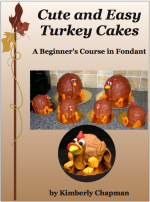For those times when you need something to go with a fix-it theme or something more rugged than flowers, here’s a free tutorial on how to make cookies with little gears and various screw/nut/bolt heads. This can be applied to cupcakes and cakes easily as well.
I’m calling it “variable” because this is one of those use-what-you’ve-got scenarios. A group I was involved with back in 2017 was running a household repair cafe as part of a reuse/reduce campaign, so I had to whip these up on short notice to donate for the bake sale portion of the event. And while I do have an airbrush on hand, if I didn’t I would have just dusted the parts with edible metallic lustre dusts instead. An airbrush makes it faster, as do the right sorts of cutters and moulds, but basic mini circles (and remember, the back end of any icing tip is a mini circle cutter!) and a couple of other wrong-end-of-the-tool hacks will help you make some fun treats really fast.
The Mini Tool Decorations
I used mini circle and hex plunger cutters (I also have non-plunger ones, the plunger ones just make it faster) to punch out a bunch of hex nut shapes (rolled thick) and screw heads (rolled slightly thinner) of various types. For the flat-head screws, I indented them with the back of a paring knife. For the little Phillips ones (that’s the one that looks like an x), I used my Sugar Shaper yellow mini firm tip twice crossing, but you could use any small, flat edge to make that effect. For the round indentations, I used the back of one of my brushes. For that spiky round ones I used the back end of a little plastic fondant tool. Basically, look around at your tools to see what kinds of shapes various parts of the tools can make. You want ones with squared edges, not sloped, because most screw heads have a flat inside to their holes. So a sharp-point tool isn’t a great choice, but go with whatever you’ve got that looks good to you.
Don’t use actual tools, even newly-purchased ones, as many tools contain toxic metals and/or are covered in oil to keep them from rusting. Actual tools are not food safe!
I also used a mini gear mould made by The Black Cherry Cake Company but they seem to have disappeared since I made these. There are other gear moulds around, though. Just don’t buy a knockoff junky one because this is definitely an application where you will need good-quality, rigid silicone if you want to get good shapes out, and knockoff moulds are usually soft, jelly-like silicone that do not do well with small, intricate shapes because the cheap silicone stretches when you push something into the mould.
You could also hand-cut some gears by using two sizes of mini circle cutters to make rings and then cutting teeth around the edge, but that would be fairly tedious. I think I paid something like £6ish for this mould back in 2016 and the time savings was definitely worth it.
I used grey fondant for the shapes (as in, I purchased white and tinted it grey with some black food gel). Then I airbrushed them with Amerimist silver all over, and then used a few small bursts of Amerimist copper from only one or two angles to give a hint of rusty discolouration without overdoing it. Then I let them dry thoroughly overnight.

In fact, go easy with the silver too. One thin coat is enough to give them a metallic shine without looking like chrome. I tried hitting a few of these with the tiniest bit of black Amerimist but it risked overpowering the metallic look, so I didn’t do many that way.
Preparing The Cookies
I always use The Pink Whisk’s Biscuits for Decorating – Non Spreading, No Chilling Required! recipe for fast, easy, tasty sugar cookies using UK ingredients. This recipe may not work as well for other types of flour and butter in other regions, so use the sugar cookie recipe that works best for you.
I have the Ateco Plain Hexagon cutter set, and picked one of the middle sizes for a nice, angular, tool-evoking shape. You can use rounds or squares, it’s all good.
Next for the base coating. Here’s a brilliant hack you’ll love for saving time and producing delicious cookies: use chocolate fondant or modelling chocolate to roll out and cut one pan’s worth of cookie coatings while that pan is in the oven. Modelling chocolate is slightly better in that it won’t dry out, but I think I might’ve used chocolate fondant here, honestly this was so long ago I can’t remember. I have used both at various times.
When the cookies come out, gently rub out any puffy bits on their surfaces with the back of a large, metal spoon or metal icing smoother if you have one. Think of it as “ironing” the cookie. Move the cookies to a cooling rack when they’re cool enough to touch and then place your pre-cut base coats on. The lingering warmth (you want warmth, NOT HEAT) will melt the modelling chocolate/chocolate fondant right on without any need to glue it down.
In this case, I used one size down in the hexagon cutter set, so I knew they’d be a perfect fit. Honestly, a good-quality graduated shape cutter set is worth it many times over if you’re going to be using that shape a lot.
Now you have beautifully-covered cookies ready to go with whatever decoration you’re adding to that base coat.
Putting It All Together
Having all the decorations made in advance makes cookie day a snap. As the cookies cool and that base coat gets solidified on, you simply glue on the mini decorations using a bit of water or – if you think water won’t hold well enough depending on which media you’re using – water with a bit of golden syrup/corn syrup/honey added. Or if you’re really fancy you can use edible glue, but that stuff is expensive so I prefer to save that for where it’s really needed on competition or other delicate work. Use whatever you think will work best for you in your situation.

I use these giant trays for decorating/drying, as they don’t fit in any standard residential British oven. This lets me make lots of trays that can be cross-stacked for drying and set out of the way, which is really crucial when making royal icing cookies.
Attach your decorations as desired and voila, relatively quick and easy tool-head cookies that everyone will love!

















